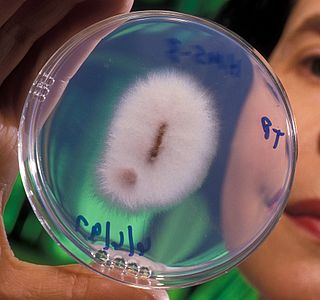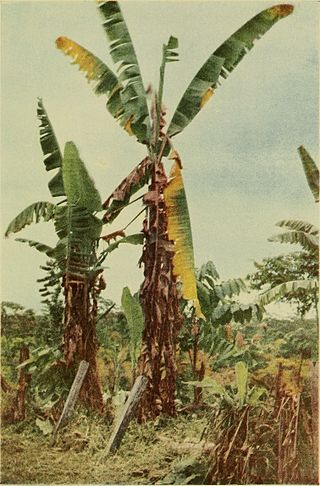Related Research Articles

Fusarium ear blight (FEB), is a fungal disease of cereals, including wheat, barley, oats, rye and triticale. FEB is caused by a range of Fusarium fungi, which infects the heads of the crop, reducing grain yield. The disease is often associated with contamination by mycotoxins produced by the fungi already when the crop is growing in the field. The disease can cause severe economic losses as mycotoxin-contaminated grain cannot be sold for food or feed.

The Oomycetes, or Oomycota, form a distinct phylogenetic lineage of fungus-like eukaryotic microorganisms within the Stramenopiles. They are filamentous and heterotrophic, and can reproduce both sexually and asexually. Sexual reproduction of an oospore is the result of contact between hyphae of male antheridia and female oogonia; these spores can overwinter and are known as resting spores. Asexual reproduction involves the formation of chlamydospores and sporangia, producing motile zoospores. Oomycetes occupy both saprophytic and pathogenic lifestyles, and include some of the most notorious pathogens of plants, causing devastating diseases such as late blight of potato and sudden oak death. One oomycete, the mycoparasite Pythium oligandrum, is used for biocontrol, attacking plant pathogenic fungi. The oomycetes are also often referred to as water molds, although the water-preferring nature which led to that name is not true of most species, which are terrestrial pathogens.

Fusarium oxysporum, an ascomycete fungus, comprises all the species, varieties and forms recognized by Wollenweber and Reinking within an infrageneric grouping called section Elegans. It is part of the family Nectriaceae.

Fusarium wilt is a common vascular wilt fungal disease, exhibiting symptoms similar to Verticillium wilt. This disease has been investigated extensively since the early years of this century. The pathogen that causes Fusarium wilt is Fusarium oxysporum. The species is further divided into formae speciales based on host plant.

Panama disease is a plant disease that infects banana plants. It is a wilting disease caused by the fungus Fusarium oxysporum f. sp. cubense (Foc). The pathogen is resistant to fungicides and its control is limited to phytosanitary measures.

Fusarium is a large genus of filamentous fungi, part of a group often referred to as hyphomycetes, widely distributed in soil and associated with plants. Most species are harmless saprobes, and are relatively abundant members of the soil microbial community. Some species produce mycotoxins in cereal crops that can affect human and animal health if they enter the food chain. The main toxins produced by these Fusarium species are fumonisins and trichothecenes. Despite most species apparently being harmless, some Fusarium species and subspecific groups are among the most important fungal pathogens of plants and animals.

Plant diseases are diseases in plants caused by pathogens and environmental conditions. Organisms that cause infectious disease include fungi, oomycetes, bacteria, viruses, viroids, virus-like organisms, phytoplasmas, protozoa, nematodes and parasitic plants. Not included are ectoparasites like insects, mites, vertebrates, or other pests that affect plant health by eating plant tissues and causing injury that may admit plant pathogens. The study of plant disease is called plant pathology.
A biopesticide is a biological substance or organism that damages, kills, or repels organisms seen as pests. Biological pest management intervention involves predatory, parasitic, or chemical relationships.
The cereal grain wheat is subject to numerous wheat diseases, including bacterial, viral and fungal diseases, as well as parasitic infestations.

Bordeaux mixture (also called Bordo Mix) is a mixture of copper(II) sulphate (CuSO4) and quicklime (CaO) used as a fungicide. It is used in vineyards, fruit-farms and gardens to prevent infestations of downy mildew, powdery mildew and other fungi. It is sprayed on plants as a preventive treatment; its mode of action is ineffective after a fungus has become established. It was invented in the Bordeaux region of France in the late 19th century. If it is applied in large quantities annually for many years, the copper in the mixture eventually becomes a pollutant. As such its use is illegal in most of the European Union. Despite this, it has been promoted as an 'organic' pesticide.
This is a glossary of some of the terms used in phytopathology.
Fusarium sporotrichioides is a fungal plant pathogen, one of various Fusarium species responsible for damaging crops, in particular causing a condition known as Fusarium head blight in wheat, consequently being of notable agricultural and economic importance. The species is ecologically widespread, being found across tropical and temperate regions, and is a significant producer of mycotoxins, particularly trichothecenes. Although mainly infecting crops, F. sporotrichioides-derived mycotoxins can have repercussions for human health in the case of the ingestion of infected cereals. One such example includes the outbreak of alimentary toxic aleukia (ATA) in Russia, of which F. sporotrichioides-infected crop was suspected to be the cause. Although current studies on F. sporotrichioides are somewhat limited in comparison to other species in the genus, Fusarium sporotrichioides has found several applications as a model system for experimentation in molecular biology.
Plant disease epidemiology is the study of disease in plant populations. Much like diseases of humans and other animals, plant diseases occur due to pathogens such as bacteria, viruses, fungi, oomycetes, nematodes, phytoplasmas, protozoa, and parasitic plants. Plant disease epidemiologists strive for an understanding of the cause and effects of disease and develop strategies to intervene in situations where crop losses may occur. Destructive and non-destructive methods are used to detect diseases in plants. Additionally, understanding the responses of the immune system in plants will further benefit and limit the loss of crops. Typically successful intervention will lead to a low enough level of disease to be acceptable, depending upon the value of the crop.

Plant disease resistance protects plants from pathogens in two ways: by pre-formed structures and chemicals, and by infection-induced responses of the immune system. Relative to a susceptible plant, disease resistance is the reduction of pathogen growth on or in the plant, while the term disease tolerance describes plants that exhibit little disease damage despite substantial pathogen levels. Disease outcome is determined by the three-way interaction of the pathogen, the plant and the environmental conditions.
This article summarizes different crops, what common fungal problems they have, and how fungicide should be used in order to mitigate damage and crop loss. This page also covers how specific fungal infections affect crops present in the United States.

Fusarium oxysporum f. sp. cubense is a fungal plant pathogen that causes Panama disease of banana, also known as Fusarium wilt. The fungi and the related disease are responsible for widespread pressure on banana growing regions, destroying the economic viability of several commercially important banana varieties.
Commonly known as Philippine downy mildew, this disease is caused by the species Peronosclerospora philippinensis of the fungal-like protist class Oomycetes, which also has members such as water molds and Phytophthora infestans, which caused the potato blight that led to the Great Irish famine.
Aspergillus giganteus is a species of fungus in the genus Aspergillus that grows as a mold. It was first described in 1901 by Wehmer, and is one of six Aspergillus species from the Clavati section of the subgenus Fumigati. Its closest taxonomic relatives are Aspergillus rhizopodus and Aspergillus longivescia.
Harold Corby Kistler is an American Adjunct Professor of biology and plant pathology at the University of Minnesota and a fellow of the American Phytopathological Society and the American Association for the Advancement of Science.
Robert Harry Stover was a Canadian-Honduran phytopathologist specializing in Musa crops and their fungal diseases.
References
- 1 2 3 4 5 6 7 8 9 10 11 12 13 14 15 16 17 18 19 20 Ainsworth, G.C. (1981). Introduction to the History of Plant Pathology. Cambridge University Press. ISBN 0-521-23032-2.
- 1 2 3 4 5 6 "History of Plant Pathology" . Retrieved 5 February 2015.
- ↑ "Plasmopara viticola, the Cause of Downy Mildew of Grapes". The Origin of Plant Pathology and The Potato Famine, and Other Stories of Plant Diseases. Retrieved 4 February 2015.
- ↑ Grace, J K (September 1988). "The Role of Thomas Taylor in the History of American Phytopathology". Annual Review of Phytopathology. 26 (1): 25–29. doi:10.1146/annurev.py.26.090188.000325.
- 1 2 3 "Fusarium oxysporum : The End of the Banana Industry?". The Origin of Plant Pathology and The Potato Famine, and Other Stories of Plant Diseases. Retrieved 4 February 2015.
- ↑ Ogilvie, Lawrence (April 1927). "An Important Virus Disease of Lilium longiflorum and its Varieties". Nature. 119 (2997): 528. Bibcode:1927Natur.119..528O. doi: 10.1038/119528b0 . S2CID 8937999.
- ↑ Diener TO (August 1971). "Potato spindle tuber "virus". IV. A replicating, low molecular weight RNA". Virology. 45 (2): 411–28. doi:10.1016/0042-6822(71)90342-4. PMID 5095900.